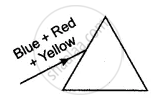Advertisements
Advertisements
प्रश्न
Why do you not see a spectrum of colours when light passes through a flat pane of glass?
उत्तर
When light passes through a flat pane of glass, the refracted light emerges out of the glass pane without any deviation because a glass pane has two sides that are parallel to each other. As the emergent light does not deviate from the original direction by any angle, we do not see the different colours of the light separated out in the form of a spectrum. Therefore, in order to view a spectrum of colours, the incident rays have to fall on an object whose surfaces are not parallel, such as a glass prism (triangular shape).
APPEARS IN
संबंधित प्रश्न
As light rays pass from air into a glass prism, are they refracted towards or away from the normal?
What will happen if another similar glass prism is placed upside down behind the first prism?
What are the seven colours seen in a rainbow?
The colour of white light which suffers the maximum bending (or maximum refraction) on passing through a glass prism is:
(a) yellow
(b) orange
(c) red
(d) violet
Which of the following coloured light has the least speed in glass prism?
(a) violet
(b) yellow
(c) red
(d) green
You are given a disc divided into seven sectors with colours violet, indigo, blue, green, yellow, orange and red in them. What would be its colour when it is rotated rapidly?
The frequency range of visible light is from 3.75 × 1014 Hz to 7.5 × 1014 Hz. Calculate its wavelength range. Take speed of light = 3 × 108 m/s.
The phenomenon of splitting of light into its component colours is ___________ .
In the figure, a beam of light consisting of three colours blue, red, and yellow is incident on a prism and on a rectangular glass block respectively. Complete the diagram by drawings of the refracted and emergent rays.

During dispersion of white light by prism placed in air, for a particular value of angle of prism,
